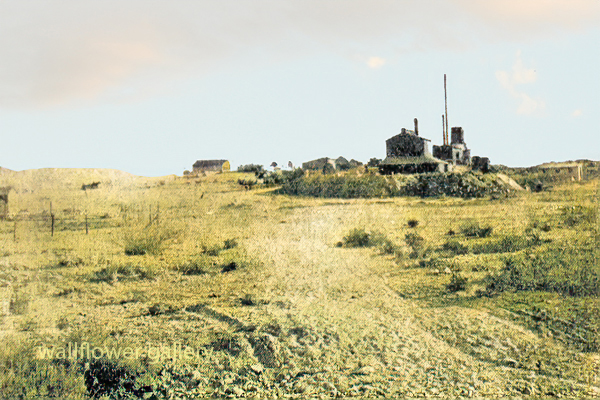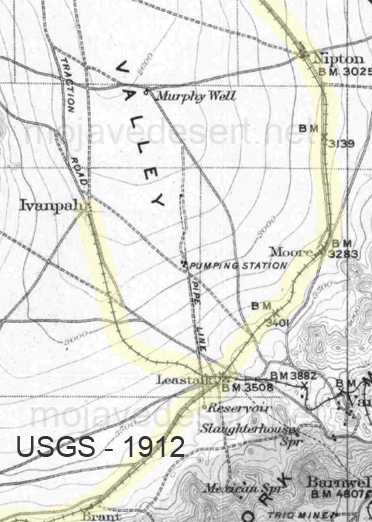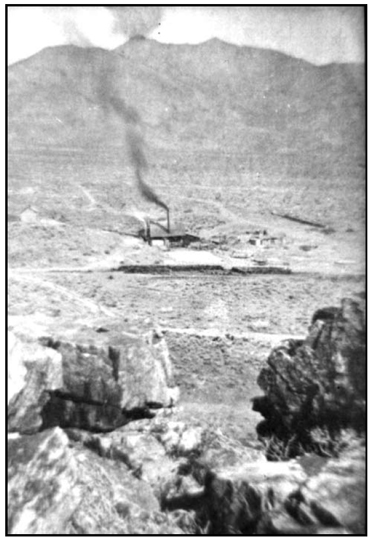Ivanpah

Copper World
What a disappointment. A newspaper publisher in
San Bernardino
had just received the annual report of the United States
Mint, yet it was full of errors and incomplete. Not a word had been
written about “our most productive mines,” near Ivanpah.
Lured by the rush to the White Pine Mining District, in northeastern
Nevada, a prospecting expedition found promising copper and silver
veins in the Clark Mountains, in the eastern Mojave Desert, in early
1869. This was about 200 miles from
San Bernardino. The party named the
district after Albert H. Clark, a businessman in Visalia, who was one of
the supporters of the expedition. The group also organized the Yellow
Pine Mining District, adjacent to the Clark district, in Nevada. The
Piute Company of California and Nevada was organized in June of 1870 to
develop the veins.
The company had an impressive pedigree. One of the trustees was John
Moss, the leader of the expedition; a noted mountain man, he maintained
friendly relations with Indians along the
Colorado River. The
secretary
was Titus F. Cronise, who had recently written an encyclopedia on the
state’s resources. The superintendent was J. W. Crossman, who was
becoming an important writer on mining.
The Piute Company planned four towns. Two of them, Cave City and
Pachocha (variously spelled), were never built. The third site was Good
Spring, in the Yellow Pine district. Ivanpah, a 160-acre townsite, was
laid out at a spring on the southeast slope of Clark Mountain, eight or
nine miles southeast of the mines.
Despite the isolation and heat, 300 men were in the district by the
summer of 1870. The first ore was shipped out in September, to San
Francisco. Freighting cost about $70 a ton, but the ore was yielding as
much as $2,000 a ton, mainly in silver. By August of 1871, Ivanpah
contained 15 buildings, including a hotel, two stores, the office and
headquarters of the Piute Company, and small houses, all of them built
of adobe, covered with good shake roofs. Three of the buildings measured
40x60 feet, including the hotel, the largest structure in town. (These
might have been tents.)
The mines were on Mineral Hill (also called Alaska Hill), eight or
nine miles northwest of the town. The most promising properties were the
Hite & Chatfield claim (later renamed the Lizzie Bullock) and the
Monitor and Beatrice, owned by the McFarlane brothers—Tom, Andrew, John,
and William. The work force included Indians, Mexicans, and Anglos;
among them were several pioneers of the Kern River mines:
Dennis
Searles,
William A. Marsh, and the McFarlane brothers. (Six miles
southwest of Ivanpah was the
Copper World
claim, which would remain
unworked for three decades.)
The original operations were primitive. The Beatrice Mine No. 2,
owned by the McFarlanes, was equipped with only a hand windlass, in
1871. John McFarlane’s house, office, and sleeping quarters, which
contained several berths, consisted of a very large tent, where he had
several mineral cabinets, which held more than 200 specimens. Since the
mines were dry, Indians were employed to haul it by pack train from
Ivanpah Spring. Mexicans were employed to work the ore in
arrastres,
or
circular stone mills. They received $125 a ton, which meant that lower
grades of ore, worth at least $150 a ton, had to be left on the dump.
Even so, the firm of Hite & Chatfield earned a $20,000 profit in
1872. Teamsters arrived from
San Bernardino
with supplies and returned
with heavy loads of ore. During six months in 1873, the mercantile firm
of Brunn & Roe forwarded $57,000 worth of ore to San Francisco.
With returns like those, the mine owners could afford to develop
their properties. In November, 1873, the McFarlane brothers put up a
small smelting furnace and a comfortable house. About early 1875, they
moved a five-stamp mill from the
New York Mountains
to a hill above
Ivanpah, where water was available. By then, their main mine, the
Beatrice, was nearly 300 feet deep. The brothers also incorporated the
Ivanpah Consolidated Mill and Mining Company, which was often called the
“Ivanpah Con.” By mid-1875, the district had produced $300,000. J. A.
Bidwell and a partner, who had bought the Lizzie Bullock Mine, built a
10-stamp mill near the Ivanpah Consolidated in 1876. It started up in
June.
Regional and national depressions, which had begun in 1875, finally
affected the Clark district in 1876. Both the Bidwell and Ivanpah
Consolidated mills had difficulty getting enough ore to run full time.
About $40,000 in attachments were filed against the Ivanpah
Consolidated. Apparently, the property was sold and operated only
intermittently through 1877, although the McFarlanes were kept on as
managers. One writer charged that the mines never had been properly
developed, having been “gouged too much by incompetent miners.”
It’s likely that Bidwell’s operation became the main producer then.
In late 1877, he overhauled his mill and increased his force at the
Lizzie Bullock Mine, to 20 in August, 1878. Both mills ran steadily, but
well into 1879, Bidwell continued to send out heavy loads of bullion,
including one shipment worth $8,000.
The camp reached its peak about then. A post office was established
in June of 1878. By April of 1879, when more than 100 hands were working
on Alaska Hill, the business district comprised two saloons, stores,
blacksmith shops, shoemakers’ shops, hotels, and hay yards, besides one
butcher shop and “neat and comfortable” houses. By early 1880, about 65
people were living in town and about the same number at the mines. In
May, two printers, James B. Cook Wilmonte (Will) Frazee, started a
weekly newspaper, the Green-Eyed Monster, but they had to suspend it
after a few issues.
Though the Ivanpah Consolidated had produced a reported $500,000 in
bullion by the end of 1879, it continued to sink into debt. The owners, a
San Francisco company, resorted to issuing scrip, for which it
neglected to pay a 10% tax to the federal government. After failing to
pay its employees for several months, the company suspended work. The
government won a judgment for $1,480 and sent out E. F. Bean, a deputy
collector for the Bureau of Internal Revenue, to attach the property.
Upon his arrival, in mid-May of 1881, a dispute arose; two days later,
John McFarlane tried to shoot Bean, who managed to get off a shot first.
McFarlane died instantly. A judge in
San Bernardino
ruled that the
killing was “a clear case of justifiable homicide.”
The district shipped out at least $162,000 in treasure in 1881, but a
decline soon followed. Most of the population departed during the early
1880s. Only 11 residents remained in early 1890. About the only
businesses left in December of 1892 were a store and boardinghouse and
the post office, which Bidwell and his wife ran. Soon after collecting
mineral specimens for San Bernardino County’s exhibit at the World
Columbian Exposition, in Chicago, Bidwell died. His widow received $75
from the county. A depression followed, in June of 1893, and the price
of silver fell to 58¢ an ounce, its lowest level, in 1898. The store
closed about then. The post office was moved in April of 1899.
For nearly three decades, the Copper World discovery
remained neglected. In August of 1878, James Boyd, who owned the
property, built an experimental smelting furnace in San Bernardino, but
nothing materialized.
But that changed in 1898, when new owners began developing the
property; it would become the largest copper producer in Southern
California. A large smelter was built at Valley Wells (also called
Rosalie Wells), several miles below the mine, in early 1899; the Ivanpah
post office was moved to Valley Wells in April, and its name was
changed to
Rosalie. Eighty-five
men worked at the mine and smelter.
Every four days, long mule teams would haul 20 tons of copper
concentrate, or matte, to
Manvel,
30 miles away, and would return with
coal and supplies. The operation produced 11,000 tons of matte until
litigation forced the mine, smelter, and post office to close in July,
1900, but the Copper World was soon revived.
This time, the
California Eastern Railway
built a 16-mile extension
from
Manvel
into the Ivanpah Valley, in early 1902, and established a
shipping point. Known as Ivanpah, the station contained an agency and
telegraph office (housed in a box car), several stores, and other
buildings. From 25 to 30 persons lived there. A post office, also called
Ivanpah, was established there in August, 1903. But costly, wasteful
operations forced the Copper World to shut down after a year or two.
When the
San Pedro, Los Angeles, and Salt Lake Railroad
was completed,
in early 1905, the line passed within a few miles of Ivanpah station.
The post office was moved to nearby
Leastalk, a station at the junction
of the
Salt Lake line and California Eastern. The
Copper World
reopened
in 1906; it produced 487,000 pounds of matte in 1907 alone. But the
matte was shipped through Cima, another station on the Salt Lake line.
The operation was large enough to warrant the formation of a local of
the Western Federation of Miners. When the Copper World shut down again,
the California Eastern abandoned its station at Ivanpah. Four or five
buildings, all of them vacant, were burned in April, 1908, supposedly by
tramps—the usual suspects.
World War I drove up the price of copper (and other metals). The
Copper World was reopened in 1916, a large blast furnace was later
built, and the work force rose from six to 60. A tractor hauled the
matte to
Cima. But when the war ended, in November, 1918, metal prices
declined, and the Copper World was shut down for the last time. The
California Eastern tore up its tracks in 1921. Several years later,
Leastalk
was renamed South Ivanpah, which was soon shortened to Ivanpah.
The post office remained open until 1966.
Ivanpah District
Location and History
The Ivanpah mining district is in northeastern San Bernardino County about 35 miles northeast of Baker and south of the Mountain Pass-Qark Mountain area. The district includes the mines in both the Ivanpah Range and the Mescal Range, which is just to the west. Gold mining began here at least as early as 1882, when the Mollusk mine was opened. Moderate mining activity continued in the district until about 1915, and there was some work again in the 1930s.Geology and Ore Deposits
The western part of the district is underlain predominantly by limestone and dolomite, with smaller amounts of shale, sandstone and dacite. To the east is granite and gneiss, and to the south is quartz monzonite. The gold deposits are in quartz veins or mineralized breccia, which occur chiefly in granitic rocks or gneiss, although the Mollusk vein is in dolomite. Other mineral commodities in the district are silver, copper, tungsten, tin, barite, fluorspar, and rare earths. As in the Clark mining district to the north, the metal-bearing deposits are associated with several major thrust fault zones. Mines. Kewanee, Mollusk $250,000, Morning Star, New Era, Teutonia.Bulletin 193 California Division of Mines and Geology 1976

The California Eastern Railway built a 16-mile extension from Manvel into the Ivanpah Valley, in early 1902, and established a shipping point. Known as Ivanpah

In November, 1918, metal prices declined, and the Copper World was shut down for the last time. The California Eastern tore up its tracks in 1921. Several years later, Leastalk was renamed South Ivanpah, which was soon shortened to Ivanpah.

Bidwell mill at Ivanpah